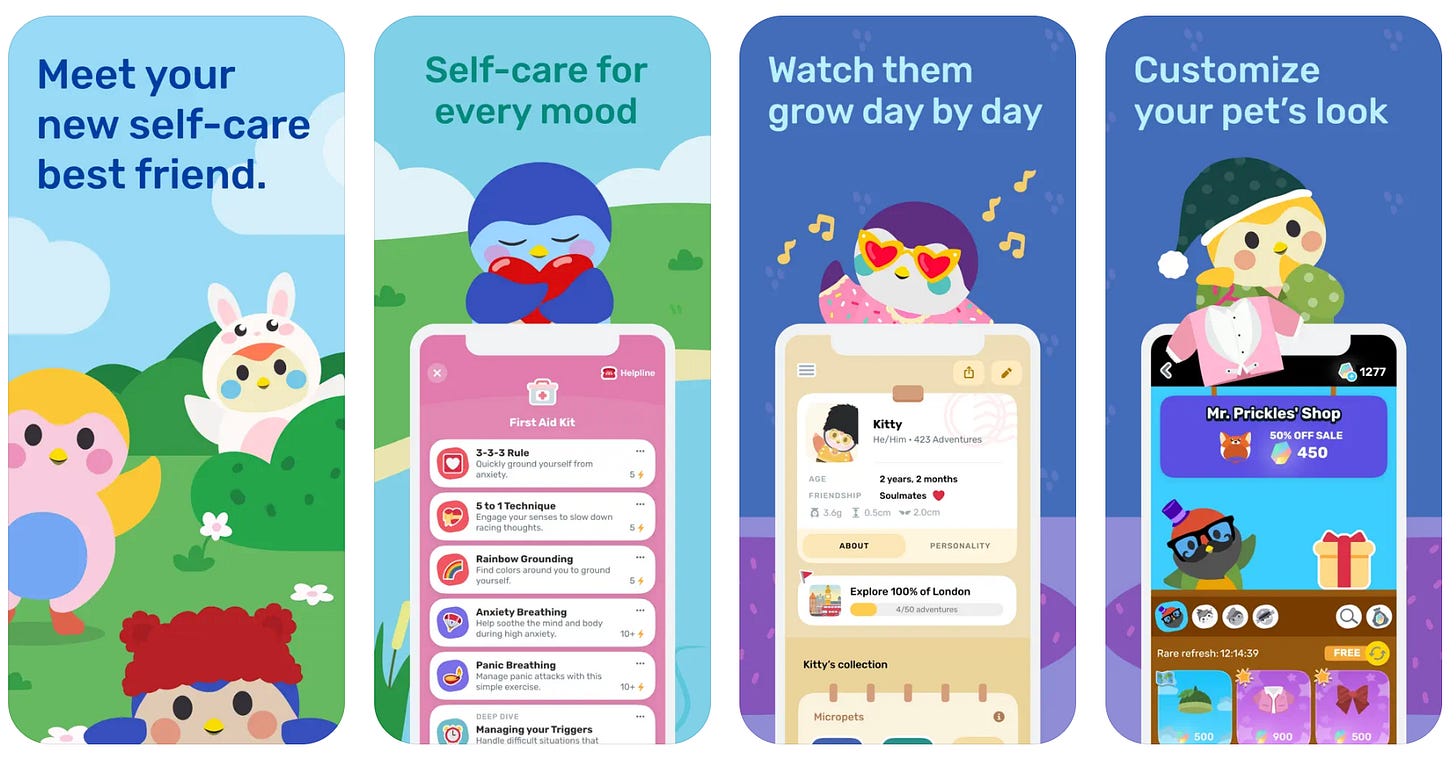Growth Ritual #85
📋 In This Issue:
The $2M/Month AI Pet Trend You're Probably Ignoring
AI, Longevity & $600B Market Everyone is Too Scared to Talk About — 🔒
How a 2% Error Can Save Your Business from Catastrophic Failure — 🔒
Know someone who’d love this? Invite them and you’ll both win—your friend discovers the newsletter, and you unlock 1 month of premium access.
The $2M/Month AI Pet Trend You're Probably Ignoring
An app called Finch is currently #5 in the Health & Fitness category, pulling in over $2 million in monthly recurring revenue.
What groundbreaking tech did they invent?
A digital pet bird you take care of by completing self-care tasks.
Yes, you read that right.
We’re talking Tamagotchi for mental health.
If you’re rolling your eyes, you’re missing the point.
This isn't just a cute trend; it's a masterclass in retention hacking and a massive, underserved market that’s just getting started.
The "AI Best Friend" niche is exploding, and while everyone else is chasing the next LLM wrapper, a few clever founders are printing money by putting a cute face on boring habits.
This is your chance to get in before it’s saturated.
The First Wave: Proof of Concept is Here
This whole thing kicked off with a simple, gamified idea: raise a cute mascot by committing to healthy habits.
Think of it as emotional accountability.
Finch: The 800-pound gorilla in the room. Launched in 2021, it now boasts $2M+ MRR and 1 million monthly downloads. Its success isn't from complex AI; it's from creating a powerful organic content loop. Users flood TikTok with posts about their progress, creating a viral distribution engine that money can't buy.
Emy: A pet BFF you can talk to. They're doing 130K downloads a month, driven almost entirely by a single TikTok account. Their most viral post? A dead-simple, funny one-slide promo that hit 8.7 million views. No fancy production needed.
Pengu: Took the model and made it social for couples. They’ve weaponized TikTok, running 11 different accounts that have generated a collective 88.9 million views with simple in-app skits.
The lesson here is simple: The core mechanic —connecting a user's real-world actions to the well-being of a digital companion—is validated. The market has spoken. They will pay for this.
Stop Competing, Start Niching
Now, here’s where the real money is. The fatal mistake would be to try and build a "better Finch". You don't have the head start or the organic moat.
The genius move?
Apply the exact same model to an overlooked, underserved niche.
This isn’t just a theory. It’s already happening.
For Bible Study: Apps like Manna and Shepherd have added AI companions to the Bible app experience. The results? Manna is already at $30,000 MRR and Shepherd is at $10,000 MRR. They found a dedicated audience and gave them a digital friend for their daily habit.
For Hydration: Two founders, Alex and Finn, literally built it in public. Their app, Sip, is a simple water reminder with a cute AI mascot. It’s brand new, but it’s the perfect example of niching down.
For Productivity: The trend just got its biggest validation yet. Hank Green, a creator with over 12 million followers, just launched Focus Friend —an app we briefly mentioned in last week’s newsletter. It’s a gamified Pomodoro timer where a virtual bean knits a scarf while you work, and it shot to #1 on the entire App Store in three days.
When a mega-creator jumps on a trend, it doesn't mean you're late. It means the market is bigger than you could have ever imagined. Hank Green is playing for the masses. You can win by targeting a specific group he’ll never serve.
Build a Niche AI BFF This Quarter
Look, I’ve built over 50 apps in my career, and I’m telling you, this is one of the most straightforward and potent opportunities I’ve seen in years.
It’s a perfect synthesis of what I write about in my books: the AI-driven vision from The AI Entrepreneur's Guide (my "Black Book") and the brick-by-brick execution from The Product Growth Playbook (the "White Book").
Here’s the simple, four-step plan:
Find a Boring, High-Retention Habit: Don't start with the character. Start with the problem. Think of a daily or weekly task people should do but often forget.
Taking medication?
Practicing a musical instrument?
Stretching after sitting for an hour?
Budgeting and tracking expenses?
Learning a new language for 15 minutes?
Create the Character & the Core Loop: Design a simple, lovable mascot. Its health, happiness, or growth must be directly tied to the user completing the target habit. This is non-negotiable.
Fake the "AI" (At First): Your "AI Best Friend" doesn't need to be powered by a custom-trained $1M model. Start with smart, personalized, pre-written notifications and encouragement. The goal is to create an emotional connection, not to pass the Turing test. The feeling of companionship is what matters.
Execute the TikTok Growth Engine: Don't reinvent the wheel. Steal the proven tactics.
The Emy Method: Blunt, funny, text-on-screen promos.
The Pengu Method: Simple screen recordings of in-app character skits.
The Finch Method: Encourage and feature organic UGC showing user progress.
This isn't a technology challenge; it's a psychology and marketing challenge.
The barrier to entry is incredibly low, but the ceiling is sky-high. You don't need a huge team or a massive influencer to launch. You just need a niche, a cute character, and a TikTok account.
The playbook is laid out for you. The market is validated from $6k/mo indies all the way up to $2M/mo giants.




